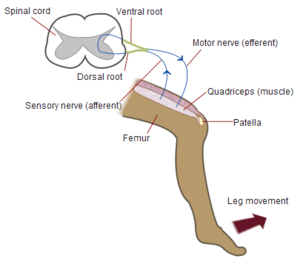Patellar reflex
The patellar reflex or knee-jerk (myotatic) (monosynaptic) (in American English knee reflex)[1] is a stretch reflex which tests the L2, L3, and L4 segments of the spinal cord.[2]

Mechanism
Striking of the patellar tendon with a reflex hammer just below the patella stretches the muscle spindle in the quadriceps muscle. This produces a signal which travels back to the spinal cord and synapses (without interneurons) at the level of L3 in the spinal cord, completely independent of higher centres. From there, an alpha motor neuron conducts an efferent impulse back to the quadriceps femoris muscle, triggering contraction. This contraction, coordinated with the relaxation of the antagonistic flexor hamstring muscle causes the leg to kick. This is a reflex of proprioception which helps maintain posture and balance, allowing to keep one's balance with little effort or conscious thought.
The patellar reflex is a clinical and classic example of the monosynaptic reflex arc. There is no interneuron in the pathway leading to contraction of the quadriceps muscle. Instead, the sensory neuron synapses directly on a motor neuron in the spinal cord. However, there is an inhibitory interneuron used to relax the antagonistic hamstring muscle (Reciprocal innervation).
This test of a basic automatic reflex may be influenced by the patient consciously inhibiting or exaggerating the response; the doctor may use the Jendrassik maneuver as a distraction or diversion in order to ensure a more valid reflex test.
Purpose of testing
After the tap of a hammer, the leg is normally extended once and comes to rest. The absence or decrease of this reflex is problematic, and known as Westphal's sign. This reflex may be diminished or absent in lower motor neuron lesions and during sleep. On the other hand, multiple oscillation of the leg (pendular reflex) following the tap may be a sign of cerebellar diseases. Exaggerated (brisk) deep tendon reflexes such as this can be found in upper motor neuron lesions, hyperthyroidism[3], anxiety or nervousness. The test itself assesses the nervous tissue between and including the L2 and L4 segments of the spinal cord.[2]
History
Wilhelm Heinrich Erb (1840–1921) and Carl Friedrich Westphal (1833–1890) simultaneously reported the patellar tendon or knee reflex in 1875 [4]. The term knee-jerk was recorded by Sir Michael Foster in his Textbook of physiology in 1877: "Striking the tendon below the patella gives rise to a sudden extension of the leg, known as the knee-jerk."[5]
In popular culture
The term began to be used figuratively from the early 20th century onwards. O. O. McIntyre, in his New York Day-By-Day column in The Coshocton Tribune, October 1921, wrote: "Itinerant preacher stemming Broadway on a soap box. And gets only an occasional knee-jerk."[5]
See also
| Look up knee-jerk in Wiktionary, the free dictionary. |
| Wikimedia Commons has media related to Patellar reflex. |
Notes
- In American English, knee-reflex is the spelling of only the adjective, not the noun.
- William J. Weiner (30 July 2010). Neurology for the Non-Neurologist. Lippincott Williams & Wilkins. pp. 499–. ISBN 978-1-60547-239-3. Retrieved 4 July 2011.
- "Endocrinology - Hyperthyroidism". Core Concepts of Pediatrics. www.utmb.edu. Archived from the original on 22 June 2016.
- Fine, Edward J.; Ziad Darkhabani, M. (2009-01-01). "Chapter 16 History of the development of the neurological examination". In Aminoff, Michael J.; Boller, François; Swaab, Dick F. (eds.). History of Neurology. Handbook of Clinical Neurology. History of Neurology. 95. Elsevier. pp. 213–233. doi:10.1016/s0072-9752(08)02116-7. ISBN 9780444520098. PMID 19892119.
- Martin, Gary. "'Knee-jerk reaction' - the meaning and origin of this phrase". Phrasefinder.
References
- Gurfinkel' VS, Lipshits MI, Popov KE (1974). "Is the stretch reflex a basic mechanism in the system of regulation of human vertical posture?". Biofizika (in Russian). 19 (4): 744–8. PMID 4425696.
- Pinnock CA, Lin ES, Smith T (2003). "Physiology of the Nervous System". Fundamentals of Anaesthesia, 2nd Edition (2nd ed.). Greenwich Medical Media Ltd.